Operation of Turbines: Pelton, Francis and Axial Flow Turbines
VerifiedAdded on 2023/04/22
|6
|1196
|429
AI Summary
Learn about the working and efficiency of Pelton, Francis and Axial Flow Turbines. Understand the limitations and disadvantages of each type of turbine. Also, know about the ecological impacts of hydroelectric power generation.
Contribute Materials
Your contribution can guide someone’s learning journey. Share your
documents today.
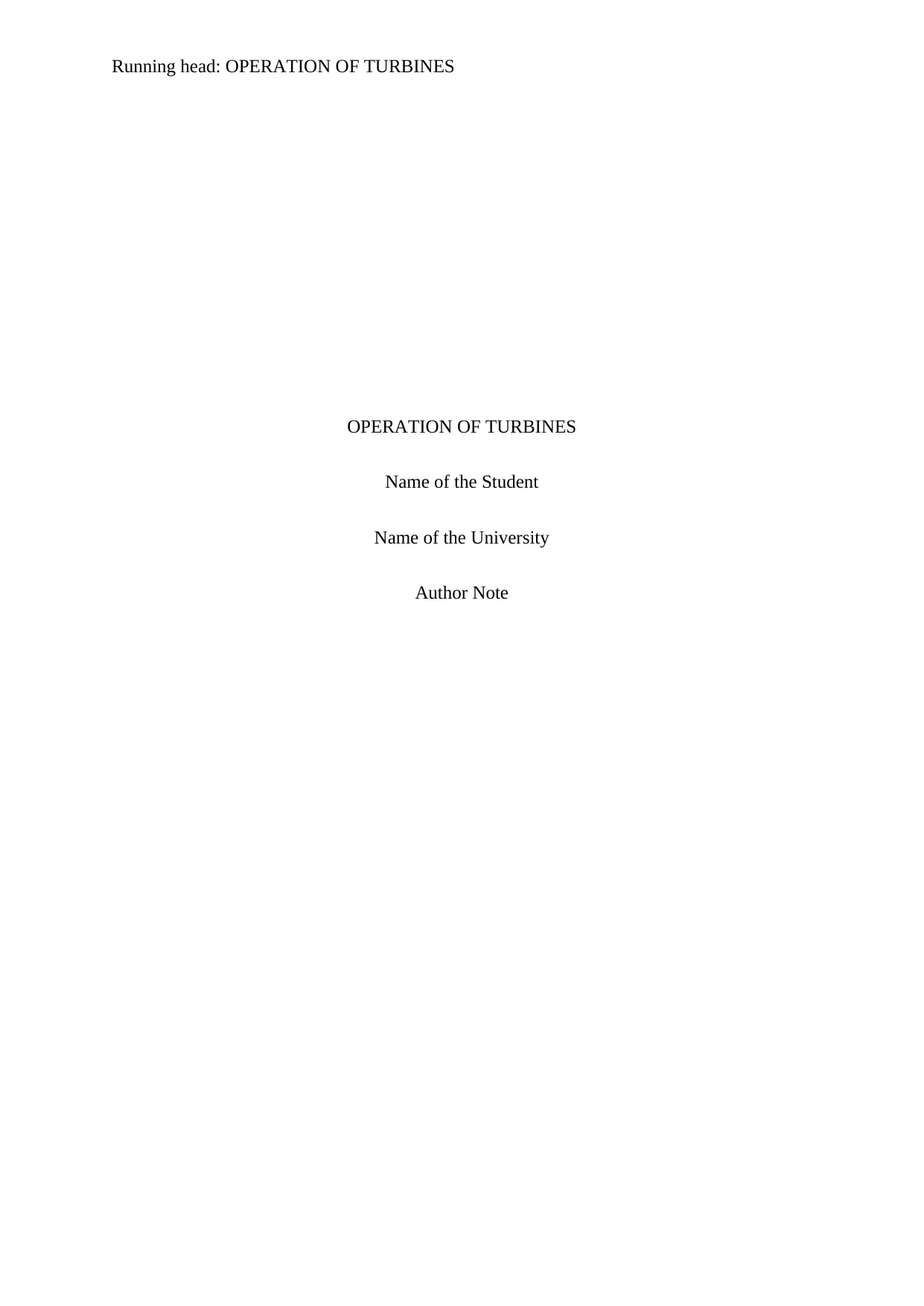
Running head: OPERATION OF TURBINES
OPERATION OF TURBINES
Name of the Student
Name of the University
Author Note
OPERATION OF TURBINES
Name of the Student
Name of the University
Author Note
Secure Best Marks with AI Grader
Need help grading? Try our AI Grader for instant feedback on your assignments.
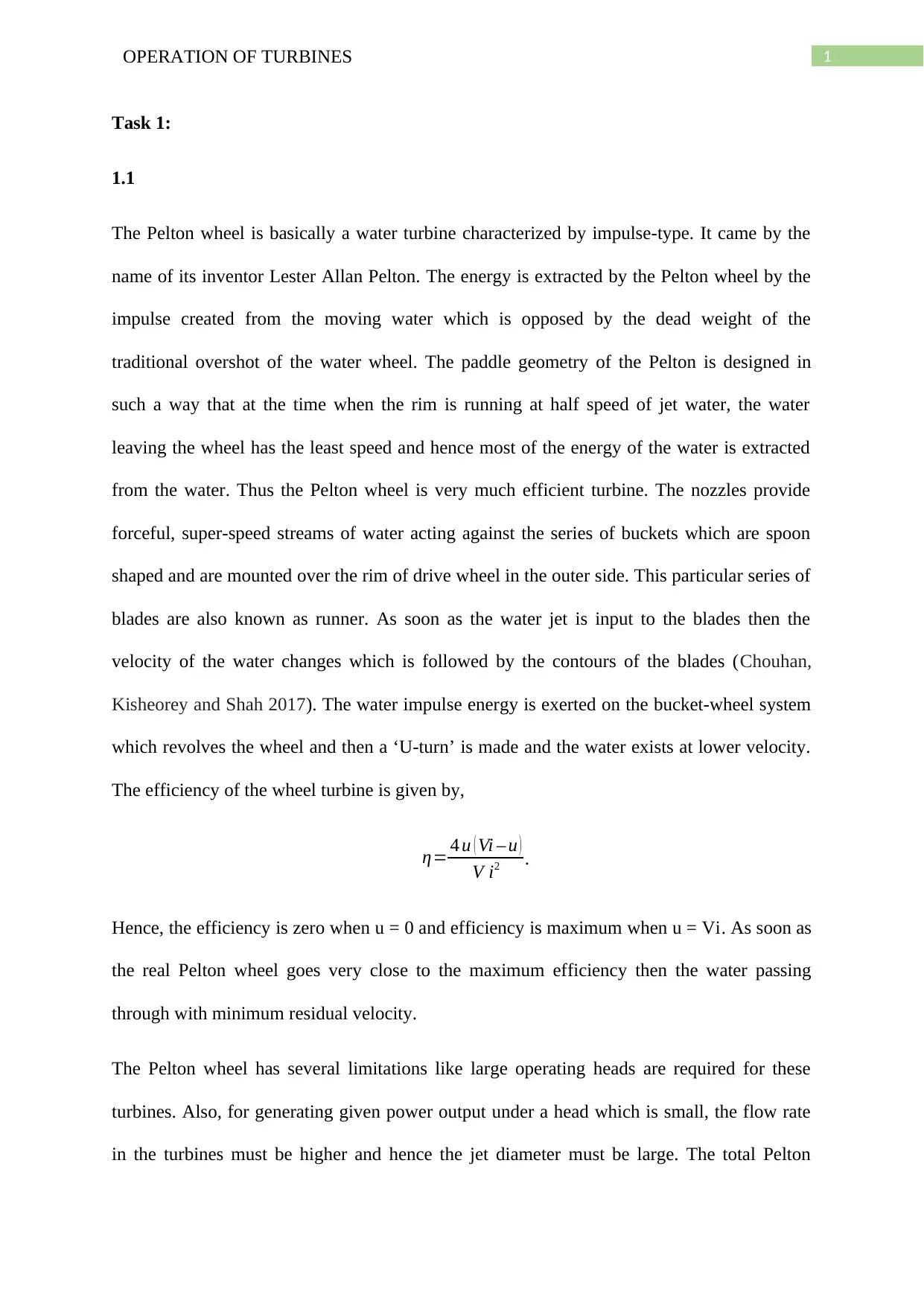
1OPERATION OF TURBINES
Task 1:
1.1
The Pelton wheel is basically a water turbine characterized by impulse-type. It came by the
name of its inventor Lester Allan Pelton. The energy is extracted by the Pelton wheel by the
impulse created from the moving water which is opposed by the dead weight of the
traditional overshot of the water wheel. The paddle geometry of the Pelton is designed in
such a way that at the time when the rim is running at half speed of jet water, the water
leaving the wheel has the least speed and hence most of the energy of the water is extracted
from the water. Thus the Pelton wheel is very much efficient turbine. The nozzles provide
forceful, super-speed streams of water acting against the series of buckets which are spoon
shaped and are mounted over the rim of drive wheel in the outer side. This particular series of
blades are also known as runner. As soon as the water jet is input to the blades then the
velocity of the water changes which is followed by the contours of the blades (Chouhan,
Kisheorey and Shah 2017). The water impulse energy is exerted on the bucket-wheel system
which revolves the wheel and then a ‘U-turn’ is made and the water exists at lower velocity.
The efficiency of the wheel turbine is given by,
η= 4 u ( Vi – u )
V i2 .
Hence, the efficiency is zero when u = 0 and efficiency is maximum when u = Vi. As soon as
the real Pelton wheel goes very close to the maximum efficiency then the water passing
through with minimum residual velocity.
The Pelton wheel has several limitations like large operating heads are required for these
turbines. Also, for generating given power output under a head which is small, the flow rate
in the turbines must be higher and hence the jet diameter must be large. The total Pelton
Task 1:
1.1
The Pelton wheel is basically a water turbine characterized by impulse-type. It came by the
name of its inventor Lester Allan Pelton. The energy is extracted by the Pelton wheel by the
impulse created from the moving water which is opposed by the dead weight of the
traditional overshot of the water wheel. The paddle geometry of the Pelton is designed in
such a way that at the time when the rim is running at half speed of jet water, the water
leaving the wheel has the least speed and hence most of the energy of the water is extracted
from the water. Thus the Pelton wheel is very much efficient turbine. The nozzles provide
forceful, super-speed streams of water acting against the series of buckets which are spoon
shaped and are mounted over the rim of drive wheel in the outer side. This particular series of
blades are also known as runner. As soon as the water jet is input to the blades then the
velocity of the water changes which is followed by the contours of the blades (Chouhan,
Kisheorey and Shah 2017). The water impulse energy is exerted on the bucket-wheel system
which revolves the wheel and then a ‘U-turn’ is made and the water exists at lower velocity.
The efficiency of the wheel turbine is given by,
η= 4 u ( Vi – u )
V i2 .
Hence, the efficiency is zero when u = 0 and efficiency is maximum when u = Vi. As soon as
the real Pelton wheel goes very close to the maximum efficiency then the water passing
through with minimum residual velocity.
The Pelton wheel has several limitations like large operating heads are required for these
turbines. Also, for generating given power output under a head which is small, the flow rate
in the turbines must be higher and hence the jet diameter must be large. The total Pelton
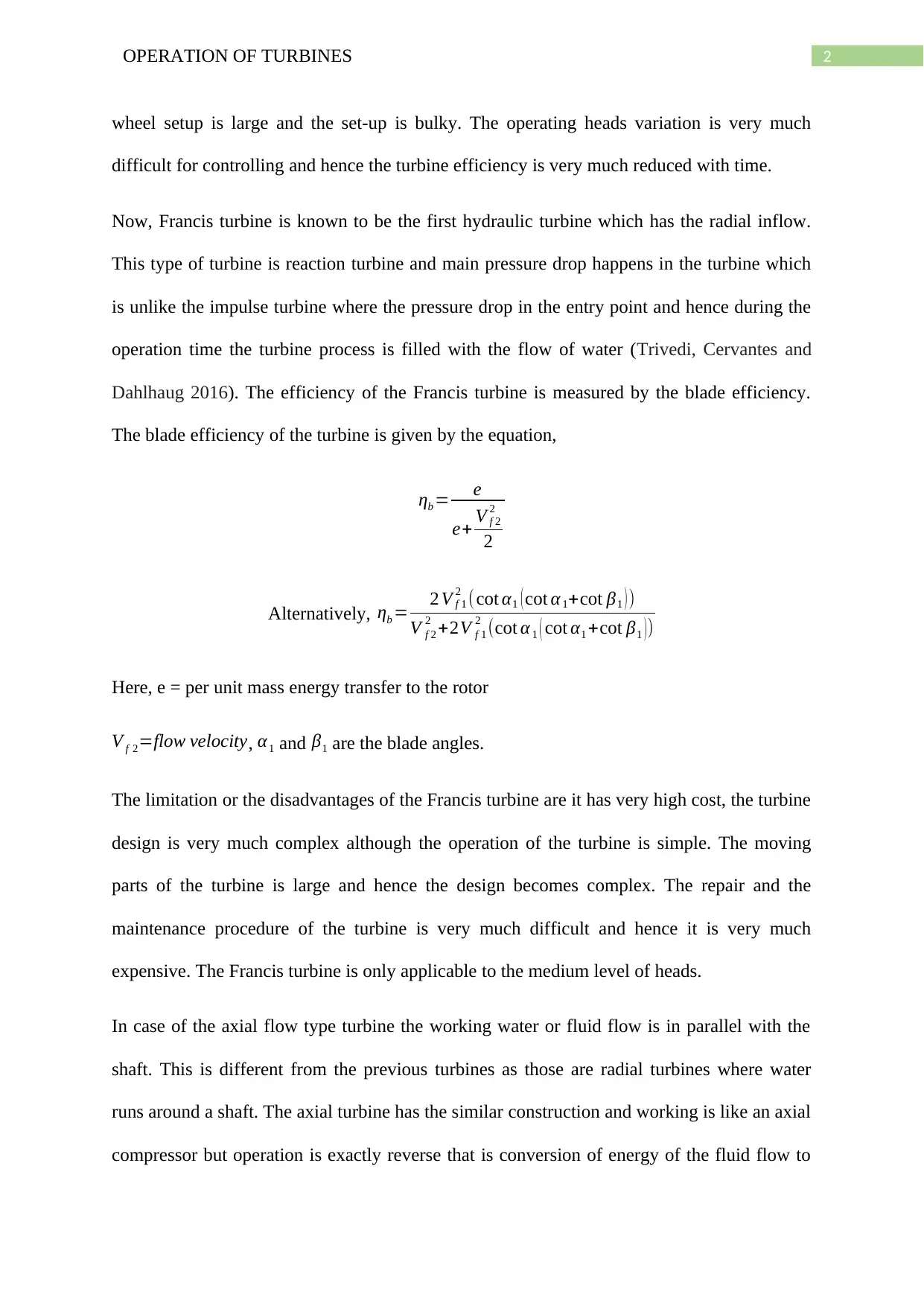
2OPERATION OF TURBINES
wheel setup is large and the set-up is bulky. The operating heads variation is very much
difficult for controlling and hence the turbine efficiency is very much reduced with time.
Now, Francis turbine is known to be the first hydraulic turbine which has the radial inflow.
This type of turbine is reaction turbine and main pressure drop happens in the turbine which
is unlike the impulse turbine where the pressure drop in the entry point and hence during the
operation time the turbine process is filled with the flow of water (Trivedi, Cervantes and
Dahlhaug 2016). The efficiency of the Francis turbine is measured by the blade efficiency.
The blade efficiency of the turbine is given by the equation,
ηb = e
e+ V f 2
2
2
Alternatively, ηb = 2 V f 1
2 (cot α1 ( cot α 1+cot β1 ) )
V f 2
2 +2V f 1
2 (cot α 1 ( cot α1 +cot β1 ) )
Here, e = per unit mass energy transfer to the rotor
V f 2=flow velocity, α1 and β1 are the blade angles.
The limitation or the disadvantages of the Francis turbine are it has very high cost, the turbine
design is very much complex although the operation of the turbine is simple. The moving
parts of the turbine is large and hence the design becomes complex. The repair and the
maintenance procedure of the turbine is very much difficult and hence it is very much
expensive. The Francis turbine is only applicable to the medium level of heads.
In case of the axial flow type turbine the working water or fluid flow is in parallel with the
shaft. This is different from the previous turbines as those are radial turbines where water
runs around a shaft. The axial turbine has the similar construction and working is like an axial
compressor but operation is exactly reverse that is conversion of energy of the fluid flow to
wheel setup is large and the set-up is bulky. The operating heads variation is very much
difficult for controlling and hence the turbine efficiency is very much reduced with time.
Now, Francis turbine is known to be the first hydraulic turbine which has the radial inflow.
This type of turbine is reaction turbine and main pressure drop happens in the turbine which
is unlike the impulse turbine where the pressure drop in the entry point and hence during the
operation time the turbine process is filled with the flow of water (Trivedi, Cervantes and
Dahlhaug 2016). The efficiency of the Francis turbine is measured by the blade efficiency.
The blade efficiency of the turbine is given by the equation,
ηb = e
e+ V f 2
2
2
Alternatively, ηb = 2 V f 1
2 (cot α1 ( cot α 1+cot β1 ) )
V f 2
2 +2V f 1
2 (cot α 1 ( cot α1 +cot β1 ) )
Here, e = per unit mass energy transfer to the rotor
V f 2=flow velocity, α1 and β1 are the blade angles.
The limitation or the disadvantages of the Francis turbine are it has very high cost, the turbine
design is very much complex although the operation of the turbine is simple. The moving
parts of the turbine is large and hence the design becomes complex. The repair and the
maintenance procedure of the turbine is very much difficult and hence it is very much
expensive. The Francis turbine is only applicable to the medium level of heads.
In case of the axial flow type turbine the working water or fluid flow is in parallel with the
shaft. This is different from the previous turbines as those are radial turbines where water
runs around a shaft. The axial turbine has the similar construction and working is like an axial
compressor but operation is exactly reverse that is conversion of energy of the fluid flow to
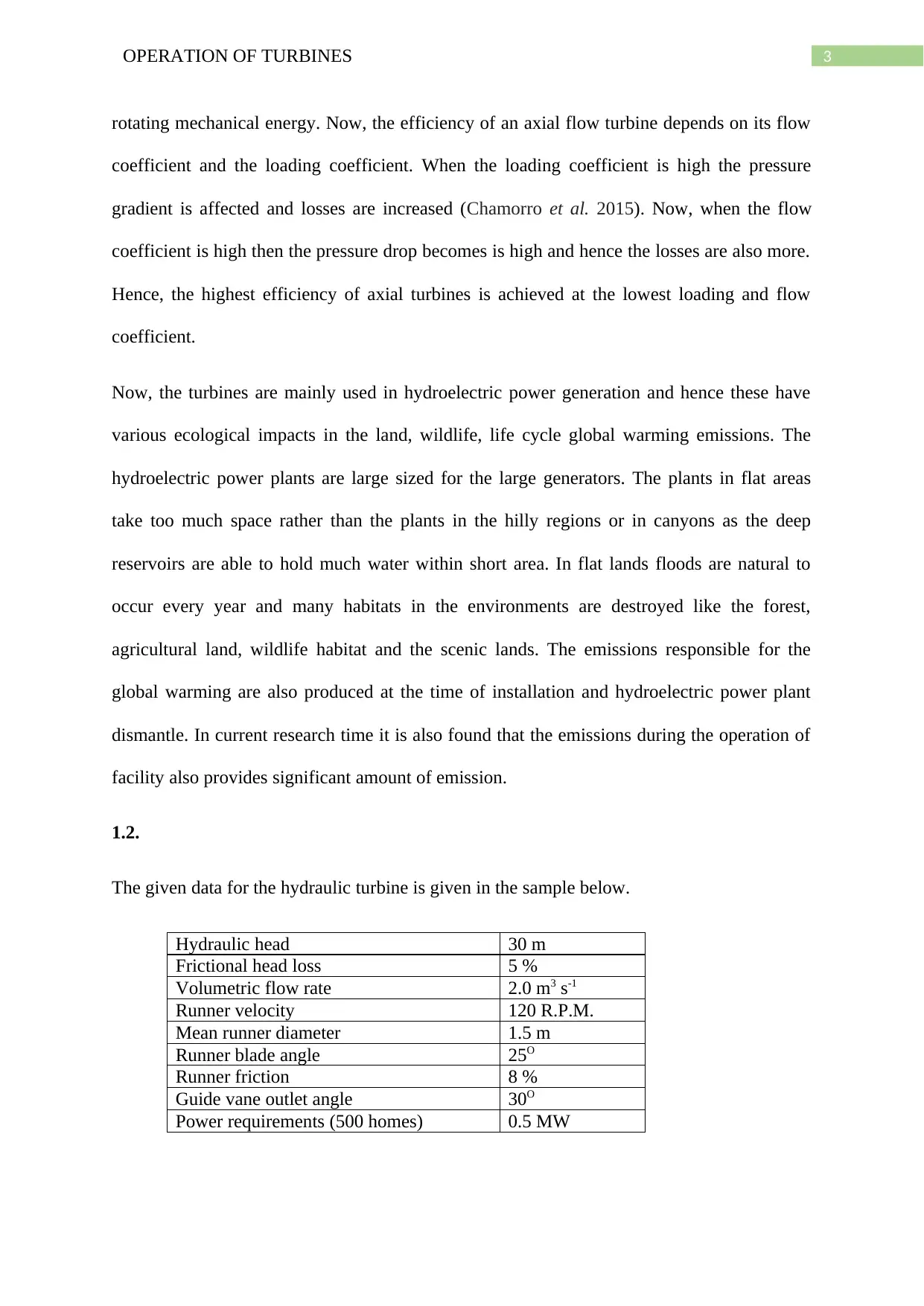
3OPERATION OF TURBINES
rotating mechanical energy. Now, the efficiency of an axial flow turbine depends on its flow
coefficient and the loading coefficient. When the loading coefficient is high the pressure
gradient is affected and losses are increased (Chamorro et al. 2015). Now, when the flow
coefficient is high then the pressure drop becomes is high and hence the losses are also more.
Hence, the highest efficiency of axial turbines is achieved at the lowest loading and flow
coefficient.
Now, the turbines are mainly used in hydroelectric power generation and hence these have
various ecological impacts in the land, wildlife, life cycle global warming emissions. The
hydroelectric power plants are large sized for the large generators. The plants in flat areas
take too much space rather than the plants in the hilly regions or in canyons as the deep
reservoirs are able to hold much water within short area. In flat lands floods are natural to
occur every year and many habitats in the environments are destroyed like the forest,
agricultural land, wildlife habitat and the scenic lands. The emissions responsible for the
global warming are also produced at the time of installation and hydroelectric power plant
dismantle. In current research time it is also found that the emissions during the operation of
facility also provides significant amount of emission.
1.2.
The given data for the hydraulic turbine is given in the sample below.
Hydraulic head 30 m
Frictional head loss 5 %
Volumetric flow rate 2.0 m3 s-1
Runner velocity 120 R.P.M.
Mean runner diameter 1.5 m
Runner blade angle 25O
Runner friction 8 %
Guide vane outlet angle 30O
Power requirements (500 homes) 0.5 MW
rotating mechanical energy. Now, the efficiency of an axial flow turbine depends on its flow
coefficient and the loading coefficient. When the loading coefficient is high the pressure
gradient is affected and losses are increased (Chamorro et al. 2015). Now, when the flow
coefficient is high then the pressure drop becomes is high and hence the losses are also more.
Hence, the highest efficiency of axial turbines is achieved at the lowest loading and flow
coefficient.
Now, the turbines are mainly used in hydroelectric power generation and hence these have
various ecological impacts in the land, wildlife, life cycle global warming emissions. The
hydroelectric power plants are large sized for the large generators. The plants in flat areas
take too much space rather than the plants in the hilly regions or in canyons as the deep
reservoirs are able to hold much water within short area. In flat lands floods are natural to
occur every year and many habitats in the environments are destroyed like the forest,
agricultural land, wildlife habitat and the scenic lands. The emissions responsible for the
global warming are also produced at the time of installation and hydroelectric power plant
dismantle. In current research time it is also found that the emissions during the operation of
facility also provides significant amount of emission.
1.2.
The given data for the hydraulic turbine is given in the sample below.
Hydraulic head 30 m
Frictional head loss 5 %
Volumetric flow rate 2.0 m3 s-1
Runner velocity 120 R.P.M.
Mean runner diameter 1.5 m
Runner blade angle 25O
Runner friction 8 %
Guide vane outlet angle 30O
Power requirements (500 homes) 0.5 MW
Secure Best Marks with AI Grader
Need help grading? Try our AI Grader for instant feedback on your assignments.

4OPERATION OF TURBINES
The hydraulic efficiency is given by,
Hydraulic efficiency = runner power/water power = (120*30)/(0.5*10^6) = 7.2%.
The hydraulic efficiency is given by,
Hydraulic efficiency = runner power/water power = (120*30)/(0.5*10^6) = 7.2%.
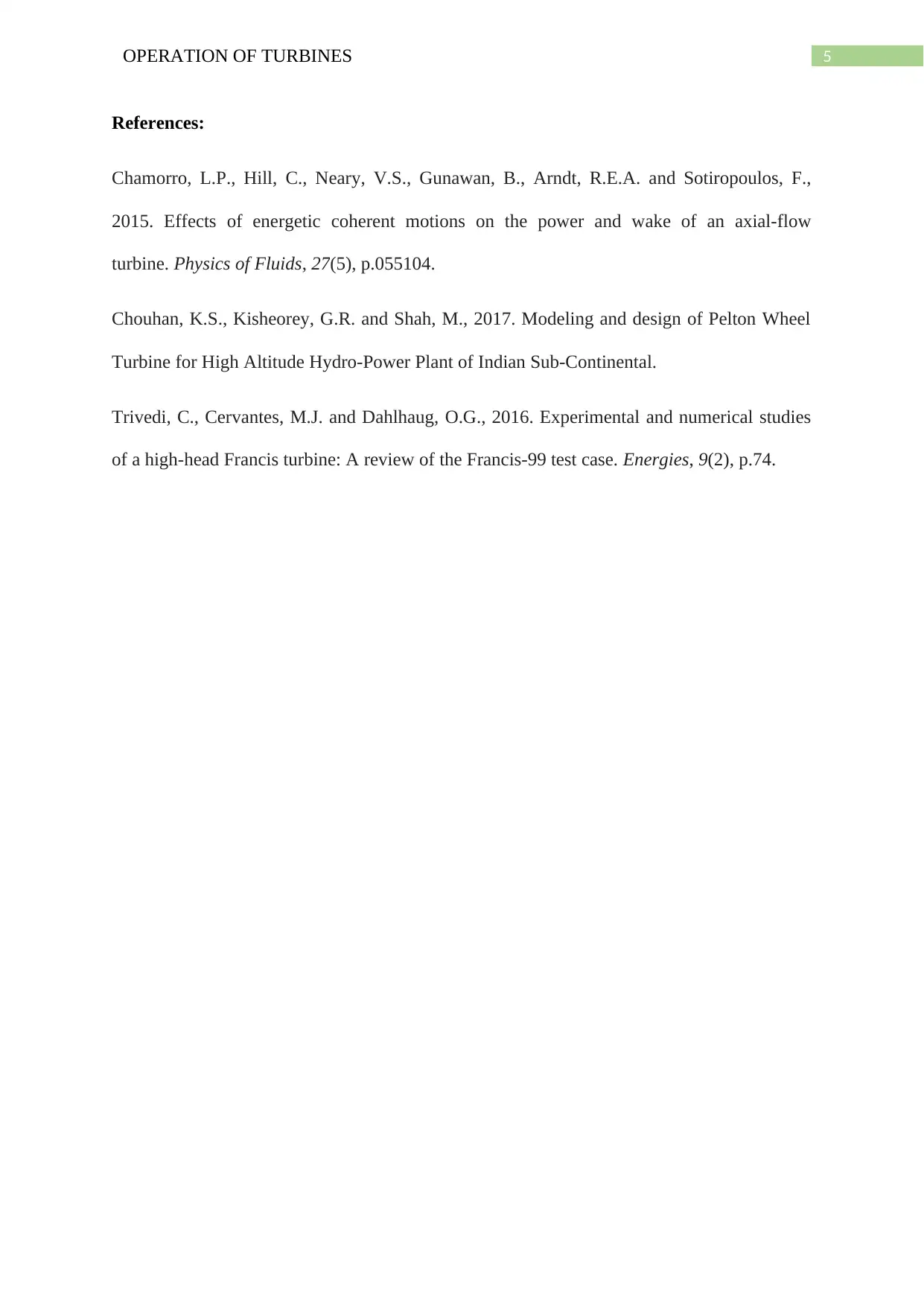
5OPERATION OF TURBINES
References:
Chamorro, L.P., Hill, C., Neary, V.S., Gunawan, B., Arndt, R.E.A. and Sotiropoulos, F.,
2015. Effects of energetic coherent motions on the power and wake of an axial-flow
turbine. Physics of Fluids, 27(5), p.055104.
Chouhan, K.S., Kisheorey, G.R. and Shah, M., 2017. Modeling and design of Pelton Wheel
Turbine for High Altitude Hydro-Power Plant of Indian Sub-Continental.
Trivedi, C., Cervantes, M.J. and Dahlhaug, O.G., 2016. Experimental and numerical studies
of a high-head Francis turbine: A review of the Francis-99 test case. Energies, 9(2), p.74.
References:
Chamorro, L.P., Hill, C., Neary, V.S., Gunawan, B., Arndt, R.E.A. and Sotiropoulos, F.,
2015. Effects of energetic coherent motions on the power and wake of an axial-flow
turbine. Physics of Fluids, 27(5), p.055104.
Chouhan, K.S., Kisheorey, G.R. and Shah, M., 2017. Modeling and design of Pelton Wheel
Turbine for High Altitude Hydro-Power Plant of Indian Sub-Continental.
Trivedi, C., Cervantes, M.J. and Dahlhaug, O.G., 2016. Experimental and numerical studies
of a high-head Francis turbine: A review of the Francis-99 test case. Energies, 9(2), p.74.
1 out of 6
Your All-in-One AI-Powered Toolkit for Academic Success.
+13062052269
info@desklib.com
Available 24*7 on WhatsApp / Email
![[object Object]](/_next/static/media/star-bottom.7253800d.svg)
Unlock your academic potential
© 2024 | Zucol Services PVT LTD | All rights reserved.

